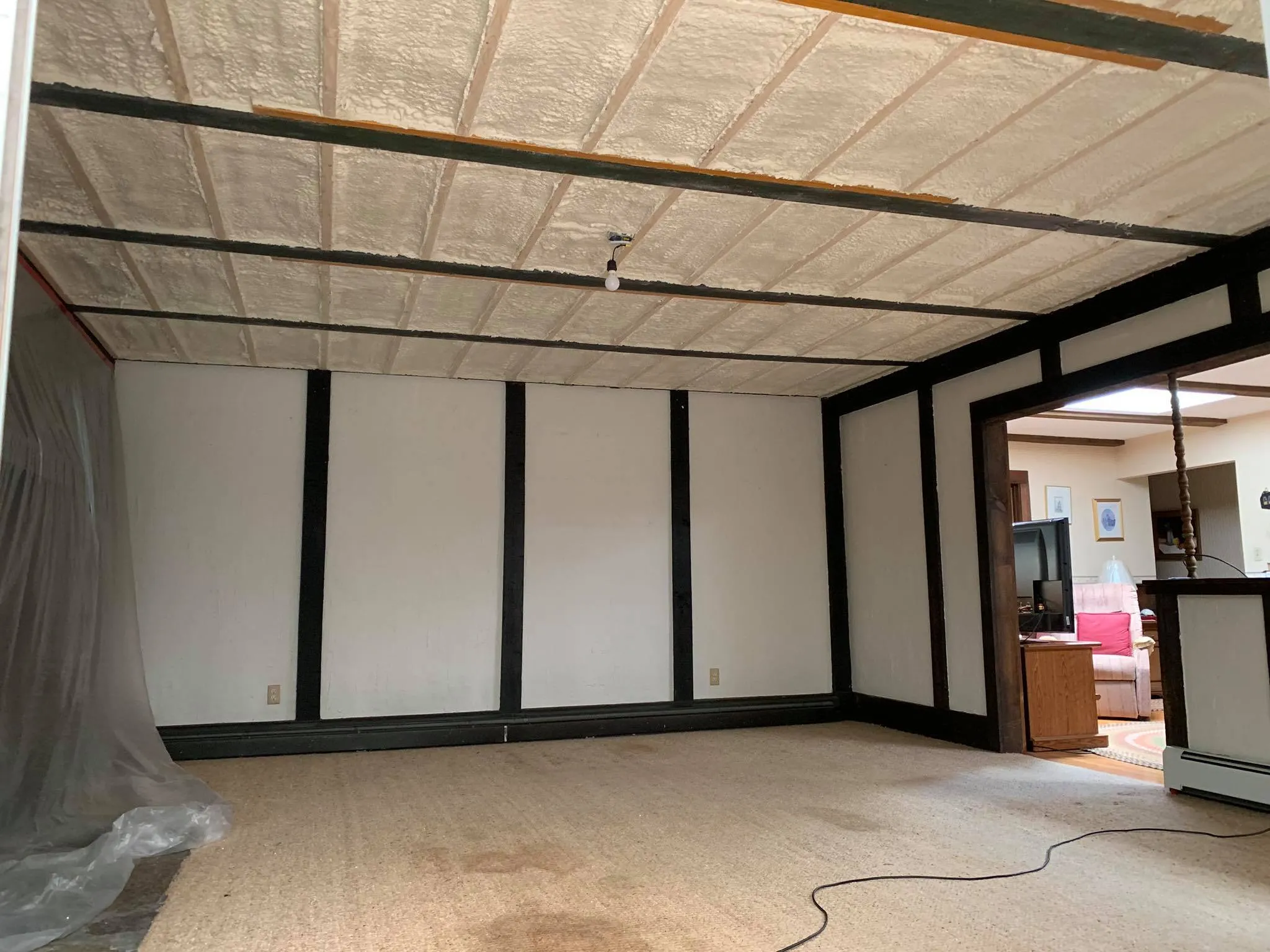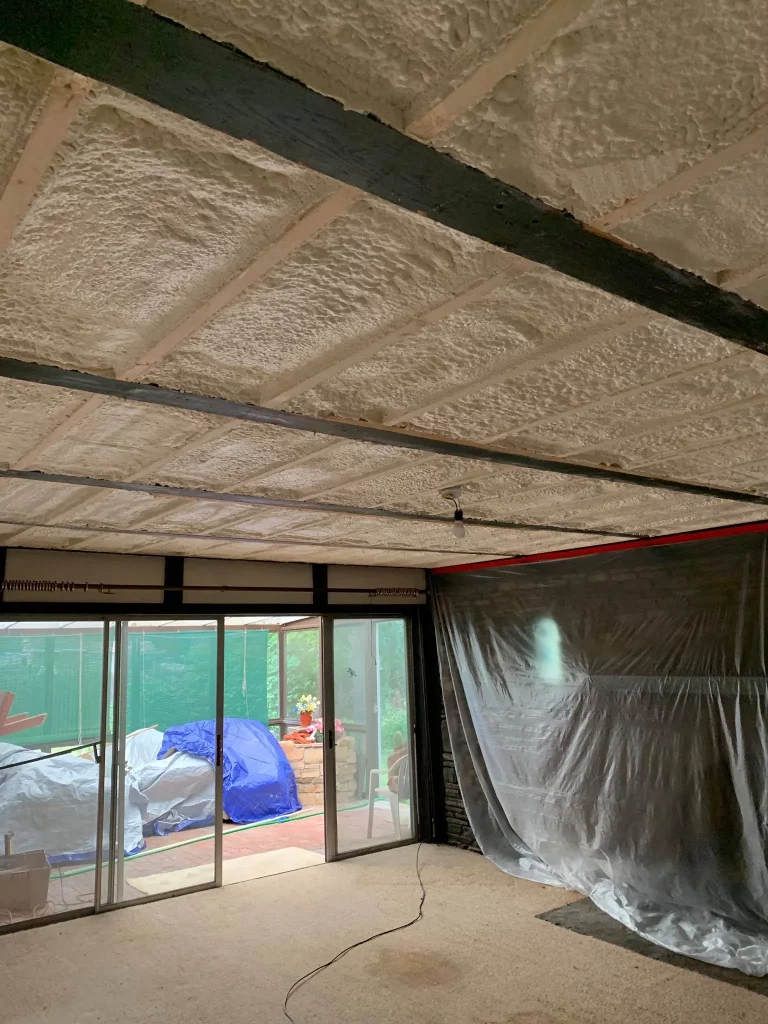
The reason spray foam insulation provides a much stronger thermal barrier than fiberglass comes down to one critical factor: air movement. While fiberglass can slow heat transfer through conduction, it does little to stop air leakage. Spray foam, on the other hand, acts as both an insulator and an air barrier. By expanding to fill every crack and gap, it creates a complete air seal that fiberglass batts simply cannot match. This dual function is what makes it a superior solution for thermal performance.
This article will break down the specific performance differences between these two materials, covering R-value, air sealing, and moisture control. The information is based on years of hands-on experience installing and evaluating insulation systems in a variety of building types. Understanding how these materials actually function inside a wall cavity is key to making an informed decision for any home or building.
Many people focus solely on R-value, which measures an insulation’s resistance to conductive heat flow. While important, R-value on its own doesn’t tell the whole story. A significant amount of energy loss in a building happens through convection, which is heat transferred by moving air.
Fiberglass batts are porous. Air can easily pass through and around them, carrying heated or cooled air with it. A report from the U.S. Department of Energy explains that uncontrolled air leakage can account for a large portion of a home’s heating and cooling costs. Even a small gap can undermine the performance of an entire wall of fiberglass insulation.
Spray foam insulation creates a solid, seamless barrier that air cannot penetrate. When applied, the foam expands to fill every void, bonding to the studs, sheathing, and any pipes or wiring. This eliminates the air gaps that plague fiberglass installations, stopping convective heat loss in its tracks.
The installation method and material properties directly affect how well an insulator manages the real-world challenges of air and moisture.
Fiberglass insulation typically comes in pre-cut batts designed to fit standard stud spacing. In a perfect world, these would fit snugly. In reality, walls have electrical outlets, plumbing, and non-standard framing that require the batts to be cut and fitted. This process almost always creates gaps, seams, and compressed areas where the insulation’s R-value is compromised. Air finds these paths of least resistance, leading to drafts and significant energy loss.
Spray foam is applied as a liquid that expands on contact, often up to 100 times its original volume. This expansion process allows it to conform perfectly to any shape, creating a custom fit for every cavity. It seals the rim joists, foundation sill plates, and attic top plates, areas that are notoriously difficult to insulate effectively with fiberglass.
Bonus Tip: Pay close attention to rim joists in basements. This area is a major source of air leakage. Spray foam is an ideal solution here because it both insulates and air-seals the junction between the foundation and the home’s wood framing.
Moisture control is another area where the materials differ greatly. Fiberglass can absorb moisture like a sponge. If it gets wet from a leak or condensation, its R-value drops sharply, and it becomes a potential breeding ground for mold.
Closed-cell spray foam, in contrast, is waterproof and acts as a vapor barrier, preventing moisture from passing through the wall assembly. This is particularly useful in damp basements or in cold climates where warm, moist indoor air can condense inside cooler wall cavities. Open-cell spray foam is not a vapor barrier, but it does allow water to drain through it, helping the wall assembly dry out if a leak occurs.
Looking at the specifications directly highlights the advantages of spray foam. The numbers show a clear difference in thermal resistance and moisture handling capabilities.
| Feature | Closed-Cell Spray Foam | Open-Cell Spray Foam | Fiberglass Batts |
|---|---|---|---|
| Typical R-Value per Inch | R-6.0 to R-7.0 | R-3.5 to R-3.8 | R-3.1 to R-3.8 |
| Air Seal | Excellent (creates a full air barrier) | Excellent (creates a full air barrier) | Poor (allows air leakage) |
| Vapor Permeability | Very Low (acts as a vapor barrier) | High (allows drying) | High (no vapor control) |
| Structural Rigidity | Adds strength to the structure | Does not add strength | Does not add strength |
| Moisture Resistance | Rejects bulk water | Allows water to drain through | Absorbs and holds water |
Data on R-values is sourced from the International Association of Certified Home Inspectors, which provides a comparative list for common insulation materials.
Choosing the right insulation involves more than just looking at performance charts. You have to consider the project’s specific needs, budget, and long-term goals.
There’s no getting around it: spray foam has a higher upfront installation cost than fiberglass. However, the long-term energy savings can often offset this initial investment. The global market for spray foam insulation continues to grow, a trend driven by stricter building codes and greater consumer demand for energy efficiency, according to a market analysis by Grand View Research. Homeowners are increasingly willing to invest in a higher-performance building envelope.
Fiberglass can be a practical choice for standard interior walls where air sealing is less of a concern. For exterior walls, attics, basements, and any area with irregular framing, spray foam’s ability to create a perfect seal makes it a far more effective option.
In cold climates like Massachusetts, preventing condensation is essential. Closed-cell spray foam’s properties as a vapor barrier are a huge advantage here, as it stops warm indoor air from contacting the cold exterior sheathing and causing moisture problems. In warmer, more humid climates, a more vapor-open insulation like open-cell foam or even fiberglass might be considered, but only if paired with a dedicated air sealing strategy.
If the objective is simply to meet minimum building code requirements, fiberglass might suffice. If the goal is to create a highly energy-efficient, comfortable, and durable home with low utility bills, the superior air-sealing and insulating power of spray foam is the clear winner.

Neither is inherently “better;” they just have different applications. Closed-cell foam has a higher R-value per inch, adds structural strength, and blocks moisture, making it ideal for exterior walls and basements. Open-cell foam is less dense, a better sound absorber, and typically less expensive, making it a good choice for interior walls.
Closed-cell spray foam does. Because of its dense, rigid structure and its ability to adhere strongly to building materials, it can help increase the racking strength of walls and roofs. Open-cell foam is soft and flexible and does not provide any structural benefit.
Spray foam is safe once it has fully cured. The installation process, however, releases chemical vapors, so it is essential that it is installed by trained professionals using proper safety equipment and ventilation. Occupants should vacate the premises during and shortly after application as recommended by the installer.
Savings vary based on the house, climate, and occupant behavior. However, by focusing on air sealing and insulation, many homeowners can achieve significant reductions in energy use. According to the U.S. Environmental Protection Agency‘s ENERGY STAR program, homeowners can save an average of 15% on heating and cooling costs by adding insulation and sealing air leaks.
The thermal performance of a building is dictated by more than just the R-value of its insulation. It depends on creating a complete thermal envelope that controls the movement of heat, air, and moisture. While fiberglass serves the single purpose of resisting conductive heat, spray foam does that while also stopping the air leakage that so often defeats traditional insulation. Before deciding, evaluate your home’s specific weak points, consider your climate, and think about your long-term energy efficiency goals.
To learn more about our expanding services and growing demand for energy-efficient solutions, read about Lamothe Spray Foam Insulation’s expansion of open-cell spray foam services in Springfield.
The best insulation strategy depends on the unique conditions of your property. A professional evaluation can identify critical areas of energy loss and recommend the most effective solution for your budget and goals. For a detailed assessment of your home’s thermal needs, you can contact Lamothe Spray Foam Insulation at (508) 847-0119 or send your questions to [email protected]. An expert opinion ensures you get the best possible performance from your investment.